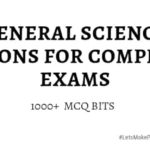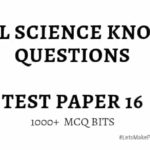General Science NCERT MCQ Bits
General Science MCQ Questions For Competitive exams
Test Paper 15
Learn General science questions for competitive exams NCERT MCQ
1. Plants can prepare their food by
a) Water
b) carbon dioxide
c) Minerals
d) All the above
d) All the above
2. Which are major sources for living organism to build their body
a) Food
b) Oxygen
c) Nutrients
d) All the above
c) Nutrients
3. Autotrophic means
a) Organisms make food themselves with complex substance
b) Organisms make food themselves with simple substance
c) Organisms make food themselves with simple and complex substance
d) None
b) Organisms make food themselves with simple substance
4. Plants are
a) Autotrophs
b) Heterotrophs
c) Both
d) None
a) Autotrophs
5. Animals are
a) Autotrophs
b) Heterotrophs
c) Both
d) None
b) Heterotrophs
Note: Autrotrophs: Prepares own food, Heterotrops: Organisms which take ready made food prepared by plants
6. Which part of the plant is known as food factories of plant
a) Root
b) Stem
c) Leaves
d) Flowers
c) Leaves
7. Tiny Pores present in leaves are surrounded by guard cell are called as
a) Cytoplasm
b) Stomata
c) Chlorophyll
d) None
b) Stomata
8. Living organisms are made of units of
a) Cells
b) Nucleus
c) Cytoplasm
d) None
a) Cells
9. Single Cell is enclosed by thin outer boundary called ?
a) Cytoplasm
b) Nucleus
c) Cell Membrane
d) None
c) Cell Membrane
10. Nucleus is surrounded by jelly like substance called
a) Cytoplasm
b) Nucleus
c) Cell Membrane
d) None
a) Cytoplasm
11. Leaves are in green color because of having green pigment called
a) Cytoplasm
b) Chlorophyll
c) Chloropaste
d) None
b) Chlorophyll
12. During Photo synthesis process, which gas is released ?
a) CO2
b) O2
c) CO
d) Both CO2 and O2
b) O2
13. Algea is in green color because ?
a) Green layer
b) Green color leaves
c) Chlorophyll
d) None
b) Chlorophyll
14. Carbohydrates are made by ?
a) Carbon dioxide, Hydrogen and Oxygen
b) Carbon, Hydrogen and Oxygen
c) Carbon monoxide, Hydrogen and Oxygen
d) None
b) Carbon, Hydrogen and Oxygen
15. Plants can not absorb which of the following gaseous form
a) Carbon dioxide
b) Nitrogen
c) Both
d) None
b) Nitrogen
16. Plants eats Insects, which are called as
a) Insect Plants
b) Hetrotrophic plants
c) Insectivorous plants
d) None
b) Insectivorous plants
17. Hetrotrophic plants are mainly divided into 4 types, which are ?
a) 1. Parasites plants 2. Saprophytes plants 3. Symbionts plants 4. Insectivorous Plants.
b) 1. Parasites plants 2. Saprophytes plants 3. Symbionts 4. Insect Plants.
c) 1. Parasites plants 2. Saprophytes plants 3. Sym plants 4. Insectivorous Plants.
d) None
a) 1. Parasites plants 2. Saprophytes plants 3. Symbionts plants 4. Insectivorous Plants.
18. Examples of Parasites plants
a) Cuscuta (Amarbel)
b) Dodder
c) Orobanche
d) All the above
b) All the above
19. Saprotrophs, which grow and live on dead and decaying organic matter of animals and plant, examples are ?
a) Monotropa
b) Rhizopus
c) Agaricus
d) All the above
b) All the above
Notes: Some example of Saprotrophs: Mucor, Yeast,
20. Symbionts plants are ?
a) Plants live on other plants which mutual benefit to each other
b) Plants live on other plants and kills other plants
c) Plants which takes water from leaves
d) None
b) Plants live on other plants which mutual benefit to each other
21. Examples of Sarprotrophs Plants ?
a) Lichens
b) Mycorrhiza
c) Both
d) Ginger plant
c) Both
22. Which Bacterium converts Nitrogen into soluble form
a) Laches
b) Rhizos
c) Rhizobium
d) Rhizobian Bacteria
b) Rhizobium
23. Leguemious plants examples ?
a) Peas
b) beans,
c) peanuts
d) All the above
d) All the above
24. Breakdown of complex components of food into simple substance is called as ?
a) Digestion
b) Ingestion
c) Breakdown process
d) Photo synthesis
b) Digestion
25. Alimentary canal consist of ?
a) Buccal Cavity
b) Oesophagus
c) Stomach
d) All the above
d) All the above
Note: It Consist of various components called Buccal Cavity, Oesophagus, Stomach, Small Intestine, Large intestine, Anus
26. Process of taking food into the body is known as
a) Digestion
b) Ingestion
c) Both
d) None
b) Ingestion
27. Arrangement of human teeth
a) 8 Incisors, 4 Canines, 8 Premolars, 8 Molars and 4 third molars
b) 4 Incisors, 4 Canines, 8 Premolars, 8 Molars and 8 third molars
c) 8 Incisors, 8 Canines, 8 Premolars, 4 Molars and 4 third molars
d) 8 Incisors, 4 Canines, 4 Premolars, 8 Molars and 8 third molars
a) 8 Incisors, 4 Canines, 8 Premolars, 8 Molars and 4 third molars
28. food pipe in humans called as
a) Stomach pipe
b) alimentary pipe
c) Alimentary canal
d) Oesophagus
b) Oesophagus
29. Inner lining of stomach secretes
a) Muscous
b) Hydrochrloric acid
c) Both
d) Gastric Acid
c) Both
30. Small Intestine is about length of
a) 2.5 meters
b) 3 meters
c) 2 meters
d) 7.5 meters
b) 7.5 meters
31. Largest gland of the body ?
a) Tongue
b) Liver
c) Both
d) None
b) Liver
32. Liver secrets __________ juices ?
a) Bile Juices
b) Acids
c) Both
d) None
b) Bile Juices
33. Which of the following plays a major role in digestions of fats ?
a) Bile Juices
b) Hydrochrloric acid
c) Both
d) None
b) Bile Juices
34. In digestion process
a) Carbohydrates brakes into glucose
b) Fats breaks into fatty acids and Glycerol
c) Proteins into amino acids
d) All the above
d) All the above
35 . Small Intestine contains finger like outgrowths called
a) Villi
b) Cells
c) Glands
d) All the above
a) Velli
36. Velli helps in
a) decrease surface area for absorption of digested food
b) Increases surface area for absorption of digested food
c) Both
d) None
b) Increases surface area for absorption of digested food
37. assimilation means ?
a) Absorption of digested food molecules into cells in the body
b) digestions food molecules into cells in the body
c) Ingestion of digested food molecules into cells in the body
d ) Movement of digested food molecules into cells in the body
d) Movement of digested food molecules into cells in the body
38. Large intestine is about ?
a) 2.5 meters
b) 3 meters
c) 1.5 meters
d) 7.5 meters
b) 1.5 meters
39. Large Intestine helps in ?
a) Digestion of food
b) Absorbs water and salts from undigested food
c) Absorbs water and salts from digested food
d) None
b) Absorbs water and salts from undigested food
40. Cows and Buffaloes stores food in ?
a) Stomach
b) Small Intestine
c) Large Intestine
d) Rumen
d) Rumen
41. Grass is rich in ?
a) Cellulose
b) Glucose
c) Both
d) None
a) Cellulose
42. Amoeba is ?
a) Multi celled organism
b) Single celled organism
c) Double celled organism
d) None
b) Single celled organism
43. Nutrition is process which consists of
a) Ingestion
b) Digestion
c) Absorption
d) All the above
d) All the above
Note: and also assimilation and egestion
44. Ameoba ingests/takes food through
a) Mouth
b) Cells
c) Pseudopodia
d) Al the above
b) Pseudopodia
45. Grazing animals are called as
a) Rumins
b) Ruminants
c) Rumen
d) All the above
b) Ruminants
46. Digestion of carbohydrates like starch begins in ?
a) Stomach
b) Tongue
c) Buccal cavity
d) All the above
c) Buccal cavity
47. Digestion of Proteins begins in
a) Stomach
b) Tongue
c) Buccal cavity
d) All the above
a) Stomach
48. Break down of food using oxygen is called ?
a) Anaerobic respiration
b) Aerobic respiration
c) Both
d) None
b) Aerobic respiration
48. Break down of food without using oxygen is called ?
a) Anaerobic respiration
b) Aerobic respiration
c) Both
d) None
a) Anaerobic respiration
50. During Inhalation, Lungs ?
a) Contracts
b) Expands
c) Both
d) None
b) Expands
Learn More
Link 1 – Physics | Biology | Indian History | T-History MCQ Questions Test papers
Link 2 – Buy/Downlaod Physics MCQ Bit Bank eBook
Link 3 – Free eBooks For Competitive Exams
Link 4 – Top Books for Competitive Exams
Link 5 – Download Quantitative and Aptitude Competitive Exams
For Complete GK/GS – Click Here
#LetsMakePreparingForGovtJobsEasy
Related Search
science general knowledge, general science quiz questions with answers, general science objective questions and answers for competitive exams, general science questions for competitive exams, science mcq, science quiz for grade 7 with answers, mcq questions for class 8 science with answers, science objective questions for competitive exams, general science mcqs with answers, bank exam study material, biology gk questions and answers in english, science quiz with answers, science related questions, science objective question in English, general science quiz questions, science quiz for class 8 with answers, general science mcq questions with answers, science general knowledge questions, Science General Knowledge Questions MCQ test papers, Science General Knowledge Questions test series

